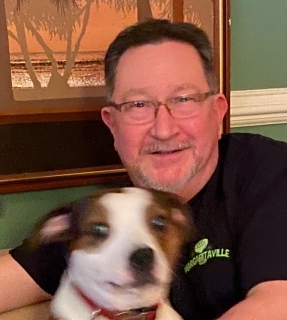3Q’s – Rus Wornom and the Endless Quest!

Today’s guest is an author who has been churning out dark, thought-provoking stories for some time and one whom I connected with a few years back when he kindly reached out to me to see about a potential blurb for his excellent ‘Ghostflowers.’ He’s had a long and storied career and has written for an IP that many of the horror world loves to play!
I’m super happy to have Rus Wornom stop by today!
Welcome Rus!

Steve: What does your process look like once you finish your first draft? Do you immediately dive back into it, or do you take some time away?
Rus: I do a little bit of everything. First, I revise while I’m writing. A lot of writers suggest not to do that, but if something that I’ve written bothers me, I fix it and move on. I’ve gotten into the habit of writing the first draft in longhand on legal pads, and then transcribing and revising into the first computer draft in Word. That helps hone the language some, but in no uncertain terms does one revised draft make a polished manuscript.
I generally tear into the first draft almost as soon as I finish. A writing professor I once had, a fine, character-based writer named Tony Ardizzone, suggested to our workshop that writers should wait a minimum of a month before revising their first draft. I don’t necessarily disagree with that, because a certain amount of time away from the manuscript will provide a little more objective perspective, and allow you to better see elements that might be working wrong. On the other hand, deadlines may not allow a writer the luxury of a month or two to start something else, so you have to go into revisions with the knowledge—and the decided opinion—that, yes, Your Shit Stinks. Hemingway was right: “The most essential gift for a good writer is a built-in, shockproof, shit detector. This is the writer’s radar and all great writers have had it.”
In other words, I revise as necessary. After I finish a second draft, I generally mull things over in my head without rereading the ms. Things will hit me—I’ll come up with a new scene, or I’ll realize that another scene isn’t working. At that point, I print out the 2nd draft manuscript and work it a little with a red pen, mostly in those areas that I’m thinking about while not really writing. Things come to writers when they’re least expected: in the shower, while driving, having a meal, and you have to take advantage of inspiration if and when it strikes.
After I add or subtract those areas that hit me unconsciously, I go back into the entire manuscript and start cutting. I tend to write long, and while SF and fantasy novels are frequently accepted for publication at about 125,000 words, publishers want mainstream novels at 100,000 words or less, and that includes horror. My longest draft of Ghostflowers ended up at 130,000. With the final and 13th draft at 113,000 words, I knew I had cut some scenes I liked and wanted, but I also knew that the novel was tighter and more straightforward.
The first draft is always the real grunt work. Cutting, pasting, revising—that’s where the magic comes in, not to mention the real fun for a writer.
Steve: What’s the one thing you’d change now if you’d have known it when you started writing?
Rus: That’s an easy one. I wish I’d known when I started out how the publishing industry was going to change over the decades. Publishing is no longer writer-friendly, and I blame that on corporations becoming giant conglomerates, corporate greed, and on Jaws and Star Wars.
When I started thinking about becoming a writer—subscribing to Locus and Writer’s Digest, taking college writing workshops—it was the 1970s. Publishing was largely a business of educated guesses and editorial needs, and of relationships between editors and writers. Woolworths across the country had long walls of paperbacks. Paperback spinner racks were in every 7-Eleven, along with comic book racks. They’re not there now, because books don’t have as high a profit margin as most corporations demand today. If you compare these past offerings to the paperback selections available in Kroger or Publix nowadays, you’d see huge differences. Then, there was more variety to the titles available. Today, it’s mostly bestsellers. Then, the authors available on the racks may have been new or unheard of. Today, it’s a selection of popular authors chosen by algorithm, based on previous, blockbuster retail sales.
Well into the 1980s, paperback publishers had a set number of books to publish a month. If I remember correctly, Warner’s Questar Books, edited by Brian Thomsen, published four or six science fiction titles a month. These schedules were filled with novels that had been agented, and some that had been found in the slush pile, and some were requested by the editor. That’s how it was done back then; the editor might have an idea for a book he’d like to publish, and he’d call a writer he knew—and he knew he could depend on— and might say, “Hey, I’d like an SF spy story that feels like something Greg Bear might write, crossed with Three Days of the Condor. I need 80,000 words in six months. You interested?”
That type of publishing has pretty much vanished. Mass market paperbacks are in short supply today because the conglomerates that have bought all the mainstream publishing houses want more of our money than ever before—and mass market paperbacks just don’t make enough for Wall Street types. Trade paperbacks have replaced them, and today’s publishers expect in 2023 that trade paperbacks will become the new hardcovers: cheaper to publish, but we’ll be charged more for them.
Publishing has changed so much because conglomerates realized there was revenue to be had by buying up a bunch of publishing houses; so now we really have only the Big 5 publishers as serious players, all because of corporate greed, combined with the bestseller mentality that has ruined a lot of things—and that came about by the back-to-back success of Jaws and Star Wars. Publishers today don’t want midlist titles, say 10-20 a year that each make respectable sales. They want only potential bestsellers. They’ve given up seeking incremental revenue and are concentrating instead on massive sales.
Hence, we now have a landscape with five big mountains, and innumerable little hills that represent indie publishers and publishing on demand. As to horror, the same rules apply: they want only bestsellers, and they don’t want to take chances on unknown writers.
Self-publishing, which has really caught on nowadays, still isn’t very profitable for most writers. So, if I were starting out today, I’d have many, many second thoughts, because the opportunities for real financial success are today stacked against creatives.
Steve: Of the books or stories you’ve released, which is your personal favorite and why?
Rus: My first three books were works for hire, written for Dungeons and Dragons in the 1990s at the request of the editor in chief: Brian Thomsen, who I mentioned above. They were in a jam with the final book in the Spelljammer series, and Brian asked me to take it over and deliver the novel in thirteen weeks. During that time, the publisher decided to create a new series called Endless Quest, basically a Choose Your Own Adventure series set in the D&D universes, and Brian called me up and asked me if I’d like to write the first two. I bring all this up as explanation for why I don’t consider these books as original works of mine, even though I wrote every word: Spelljammer: The Ultimate Helm was written by me, but based on an existing outline by the writer who had to leave the project. The Endless Quest books, Dungeon of Fear and Castle of the Undead, were juvenile derivatives of D&D. Dungeon was original to me, but the first writer of Castle was let go, and I was told I could use as much of the existing manuscript as I wanted (or not). I retained only the main character’s name, if I remember, so 99.9% of Castle is all mine. Still, they’re based on existing properties, and while I wrote them, I don’t consider them either very original nor my best work.
Ghostflowers has to be my favorite so far, simply because I lived through the era it depicts, and the ‘70s still resonate through me. Dark Shadows, vampire lore, and summers living in the South were extremely important and formative, and Ghostflowers touches a part of my secret soul. Now, the novel that my agent is currently marketing for me is also quite close to my heart, but because it’s completely different. The Enigma Club is a little bit meta: a pulp novel that plays with pulp tropes, while also subverting them for comic effect. Think circa 1930, Indiana Jones meets Monty Python, with dedicated nods to John Carter and Tarzan and the Shadow and Howard and Lovecraft. Enigma Club is a high concept novel, but Ghostflowers is more personal. The novel I’m working on right now, Shades— Well, it hates me, and I hate it. But I WILL finish it.
Steve: Bonus Fun Question – Would you rather be lost at sea or in the mountains?
Rus: Mountains. I can’t drown or get eaten by sharks.
Steve: Amazing responses, Rus. Wow! Thank you so much for this. Just phenomenal insight!
To find Rus’ work and connect – check the links!
Amazon: https://www.amazon.com/stores/Rus-Wornom/author/B0B558XM43
Twitter: https://twitter.com/RusWornom
Website: https://ruswornom.com/



